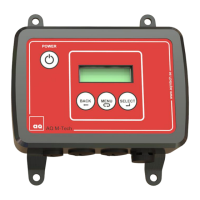16 Ultrasound Controller Manual
CALIBRATION
Calibration must be done both with air (with empty Air Sensor) and liquid (with full Air Sensor) and
it can be done in any order. To calibrate liquid, make sure there is liquid inside the Air Sensor and
select calibrate LIQUID (and press SELECT button one second). To calibrate air make sure the Air
Sensor is empty and select calibrate AIR (and press SELECT button one second). During
calibration of liquid, Ultrasound Controller adjusts the intensity of the ultrasound to become 100%.
Each Air Sensor should be calibrated after installation. After the calibration it is advisable also to
check the values in SHOW DATA (see below).
A new calibration of liquid may be required if the liquid properties has changed significantly since
the last calibration. For the Air Sensor PAC or FCP a temperature change over 20ºC requires a
new calibration of liquid. When very very low sensitivity is used a temperature change of more
than 4ºC requires a new calibration of both air and liquid.
SHOW DATA
There are two measurement techniques, normal measurement and very low sensitivity
measurement. These are then doubled into two perpendicular measurements for increased
reliability and sensitivity.
During normal measurement a beam of ultrasound is transmitted and the echo is amplified. A
bubble scatters the sound causing reduced intensity. This is how a bubble is being detected.
During very low sensitivity measurements the Air Sensor transmits ultrasound and listens to how
quickly vibrations inside the walls of the Air Sensor disappear into the liquid.
Calibration Data
The Calibration Data page shows calibration data from normal measurement. Calibration data is
measured and stored during calibration. The two data on each line correspond to the two
perpendicular measurements.
On the first line is NLiq which is the ultrasound strength measured in dB with liquid in the Air
Sensor. NLiq is usually around 40dB, depending on type of Air Sensor. A high value means strong
sound which is better than a low value. Check that NLiq is higher than 30dB for SAC and FCS,
higher than 18dB for SAC Ex, CCS Ex or FCS Ex, higher than 19dB for PAC and FCP.
On the second line is NAir which is the relative sound strength, relative to NLiq, with air in the Air
Sensor. Ideally NAir should be 0% but as sound travels around the walls it will not be 0%. Check
that NAir is less than 15%.
Normal Measurement Data
This page shows the current normal measurement data, Ndata (The two data correspond to the
two perpendicular measurements). It is the relative ultrasound strength (relative to NLiq). With
liquid in the Air Sensor, it should be near 100%, depending on the liquid. All liquids do not conduct
sound equally well. If Ndata with liquid is > 130% or if it is < 80% it is advisable to calibrate the Air
Sensor with liquid again.
With air in the Air Sensor, Ndata should be less than 15%. The threshold at which air bubble is
detected depend on sensitivity setting and type and size of Air Sensor (approximately at high
sensitivity threshold is 44% and at low sensitivity threshold is 27%).

